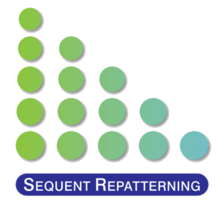Sequent repatterning therapy for misophonia: Difference between revisions
m WG5VZ moved page User:WG5VZ/sandbox to Sequent Repatterning Therapy for Misophonia: Publication Tag: |
Ira Leviton (talk | contribs) m Fixed a pmc parameter in a citation. Please see Category:CS1 maint: PMC format. |
||
| Line 3: | Line 3: | ||
[[File:SRT Logo Small Trans.png|thumb|right|alt=Image of Sequent Repatterning logo|The Sequent Repatterning therapy process is associated with this logo, registered in 2019]] |
[[File:SRT Logo Small Trans.png|thumb|right|alt=Image of Sequent Repatterning logo|The Sequent Repatterning therapy process is associated with this logo, registered in 2019]] |
||
Chris Pearson presented to the International Association of Neuropsychotherapy in 2017 and an article ''Reviewing Misophonia and its Treatment''<ref>{{Cite journal |last=Pearson |first=Christopher |date=2017 |title=Reviewing Misophonia and its Treatment |url=https://pageturner.com.au/shop/ijnpt-v5-i1/ |journal=International Journal of Neuropsychotherapy |volume=5 |issue=1 |pages=2–10 |doi=10.12744/ijnpt.2017.1.0002-0010}}</ref> was published in International Journal of Neuropsychotherapy later that year. Chris Pearson also contributed to the proposals for diagnostic criteria for misophonia, published in Frontiers.<ref>{{Cite journal |last=Dozier |first=Thomas H. |last2=Lopez |first2=Michelle |last3=Pearson |first3=Christopher |date=2017-11-14 |title=Proposed Diagnostic Criteria for Misophonia: A Multisensory Conditioned Aversive Reflex Disorder |url=http://journal.frontiersin.org/article/10.3389/fpsyg.2017.01975/full |journal=Frontiers in Psychology |volume=8 |doi=10.3389/fpsyg.2017.01975 |issn=1664-1078 |pmc= |
Chris Pearson presented to the International Association of Neuropsychotherapy in 2017 and an article ''Reviewing Misophonia and its Treatment''<ref>{{Cite journal |last=Pearson |first=Christopher |date=2017 |title=Reviewing Misophonia and its Treatment |url=https://pageturner.com.au/shop/ijnpt-v5-i1/ |journal=International Journal of Neuropsychotherapy |volume=5 |issue=1 |pages=2–10 |doi=10.12744/ijnpt.2017.1.0002-0010}}</ref> was published in International Journal of Neuropsychotherapy later that year. Chris Pearson also contributed to the proposals for diagnostic criteria for misophonia, published in Frontiers.<ref>{{Cite journal |last=Dozier |first=Thomas H. |last2=Lopez |first2=Michelle |last3=Pearson |first3=Christopher |date=2017-11-14 |title=Proposed Diagnostic Criteria for Misophonia: A Multisensory Conditioned Aversive Reflex Disorder |url=http://journal.frontiersin.org/article/10.3389/fpsyg.2017.01975/full |journal=Frontiers in Psychology |volume=8 |doi=10.3389/fpsyg.2017.01975 |issn=1664-1078 |pmc=5694628 |pmid=29184520}}</ref> It is these diagnostic steps that Sequent Repatterning practitioners apply to assessment of potential clients. |
||
Sequent Repatterning is often known as sequent repatterning therapy or SRT. Its development has continued and, during the last five years, has embraced the [[Coherence therapy|therapeutic reconsolidation process]] (TRP, a key feature in [[Coherence Therapy]]) as a key element in transformational change. |
Sequent Repatterning is often known as sequent repatterning therapy or SRT. Its development has continued and, during the last five years, has embraced the [[Coherence therapy|therapeutic reconsolidation process]] (TRP, a key feature in [[Coherence Therapy]]) as a key element in transformational change. |
||
Revision as of 13:27, 7 August 2023
Sequent Repatterning
Sequent Repatterning therapy was developed as a specific therapy to help those having misophonia. Its development began in 2012 when Christopher Pearson applied aspects of hypnotherapy, parts work therapy and NLP to create a therapy model which fits the condition misophonia.

Chris Pearson presented to the International Association of Neuropsychotherapy in 2017 and an article Reviewing Misophonia and its Treatment[1] was published in International Journal of Neuropsychotherapy later that year. Chris Pearson also contributed to the proposals for diagnostic criteria for misophonia, published in Frontiers.[2] It is these diagnostic steps that Sequent Repatterning practitioners apply to assessment of potential clients.
Sequent Repatterning is often known as sequent repatterning therapy or SRT. Its development has continued and, during the last five years, has embraced the therapeutic reconsolidation process (TRP, a key feature in Coherence Therapy) as a key element in transformational change.
For those having misophonia, therapy often begins with a structured programme with a suitably qualified therapist. This programme consists four distinct phases, categorised as
- Pre-therapy
- Foundation
- Active Therapy
- Future Pacing
and is usually completed over a period of about three months. At the conclusion of the Active Therapy Phase, around 80% of those engaging with the process achieve a significant improvement in symptom severity, as measured by the scale MAQ-4. The reduction in MAQ-4 score that aligns with 'significant improvement' is 20%. The current (2023) arithmetic average improvement of that 80% is a reduction of around 70%.
Training for Sequent Repatterning practitioners is restricted to those already meeting specific skills and professional credentials. Those assigned the status of Certified Sequent Repatterning Practitioner will have completed a comprehensive training course, followed by assessment fo a case study. More can be found out about Sequent Repatterning and those therapists who use this approach to working with misophonia at the web site www.sequent-repatterning.com Each member of the Sequent Repatterning therapeutic community participates in clinical supervision, peer review and a regular, monthly Round Table exchange of information to maintain and enhance clinical outcomes for their clients. Presently (2023) there are accredited therapists in UK, mainland Europe, South Africa, United States of America and Australia, providing global coverage utilising VSee - the purpose-designed telemedicine platform - and Zoom to deliver therapy remotely, as well as some members of the team meeting with individuals in person, in their therapy rooms.
- ^ Pearson, Christopher (2017). "Reviewing Misophonia and its Treatment". International Journal of Neuropsychotherapy. 5 (1): 2–10. doi:10.12744/ijnpt.2017.1.0002-0010.
- ^ Dozier, Thomas H.; Lopez, Michelle; Pearson, Christopher (2017-11-14). "Proposed Diagnostic Criteria for Misophonia: A Multisensory Conditioned Aversive Reflex Disorder". Frontiers in Psychology. 8. doi:10.3389/fpsyg.2017.01975. ISSN 1664-1078. PMC 5694628. PMID 29184520.
{{cite journal}}: CS1 maint: unflagged free DOI (link)
